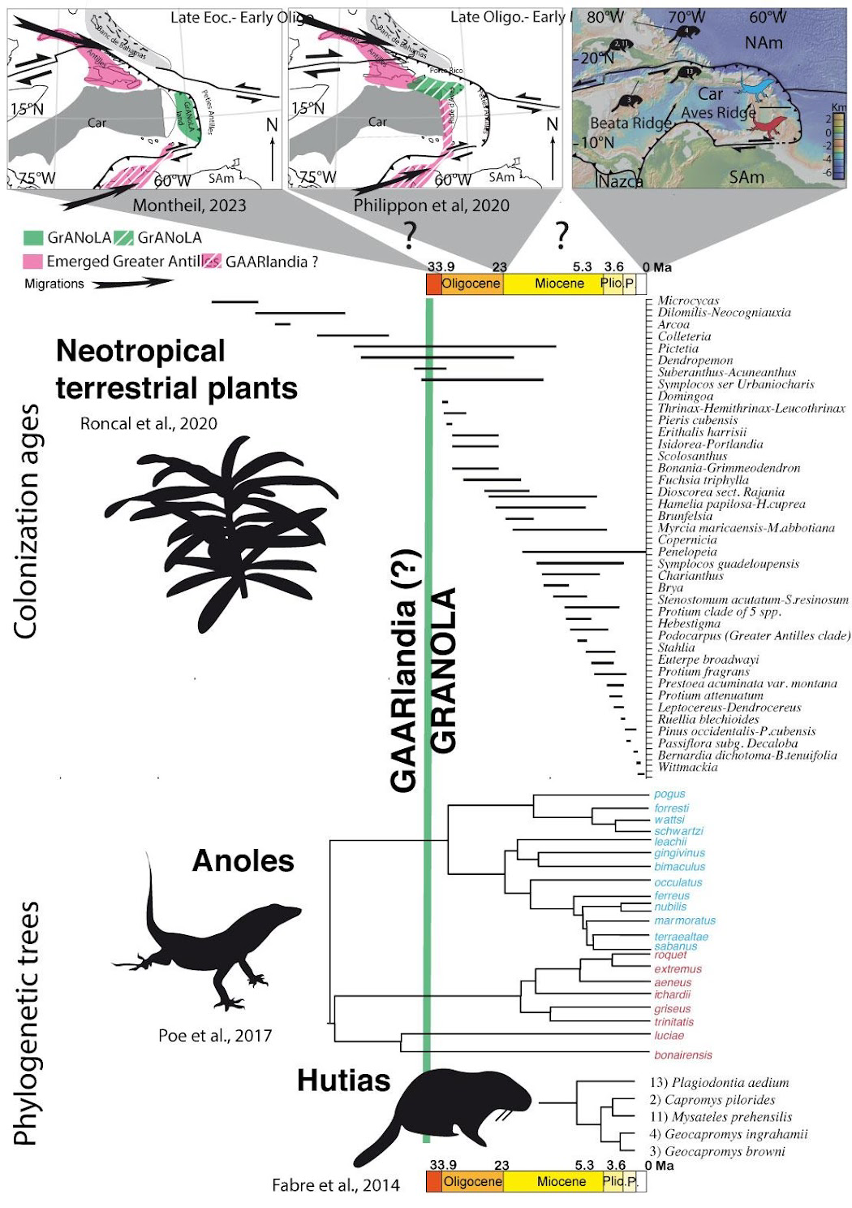ANR SUBUTTEC
SUBdUction Triggered Terrestrial Evolution in the Caribbean
Funding : ANR PRC, 467.148,99 €
Coordinator : Mélody Philippon (Géosciences Montpellier)
Host institution: UMR 5243 Géosciences Montpellier
Partners :
- UMR BOREA
- UMR ISYEB
- ISTerre
- Laboratoire de Géologie de Lyon
Duration : 2024 – 2028

Abstract:
The SUBUTTEC project combines geological and biological data to elucidate the links between subduction dynamics and the evolution of terrestrial life in subduction zones, based on the study of a biodiversity hotspot: the Lesser and Greater Antilles. This short, dynamic subduction zone is ideally circumscribed by two giant continents and two equally giant oceans, providing rather static boundary conditions. Paleogeographic reconstructions of the last 20 million years, focusing on the unknown role of the southern Lesser Antilles, will be carried out by integrating tectonics, paleomagnetism, (bio-)stratigraphy and geochronology. These reconstructions will be matched with the phylogenetic record of extant endemic species, providing an independent data set to constrain the temporal evolution of life. The implementation of comparative biogeographic methods here provides a powerful tool for revealing the natural classification of biogeographic zones, i.e. bioregionalization and the identification of vicariant events. The joint analysis of geological and biological data will provide a macro-ecological framework for the dynamics of the biosphere in subduction zones.
By combining ultra-rapid non-equilibrium conditions with high thermo-mechanical stresses, we aim to identify the sources and processes of transformation. Our approach is based on the use of spatio-temporally modulated irradiation sources, observation of structural dynamics, simulation of new phases and assessment of their mechanical properties. The multidisciplinary DENSE consortium (LabHC, FEMTO-ST, LaMCoS, LGF-EMSE and LGL-TPE) has extensive expertise in laser beam engineering, laser phenomena probing, material transformation simulation and glassy materials, as well as skills in electronic, structural and mechanical characterization, to best meet the challenges posed by the project. The challenge for DENSE is to raise energy deposition to record levels, validate transformation scenarios based on dynamic evolution, and increase our understanding of material structure, metastability and mechanical properties.

Paleogeographic reconstruction of the eastern part of the Caribbean plate during the Eocene-Oligocene and Oligocene-Miocene transitions (from Boschman et al., 2014) and current tectonic map showing the ranges of Hutias and Anolis spp. (simplified from Fabre et al., 2014 and Poe et al., 2017). Emergent lands belonging to GAARlandia (Greater Antilles Aves Ridges land, Itturalde-Vinente and McPhee, 1999) and GrANoLA are shown in pink and green, respectively (modified from Philippon et al., 2020; Montheil, 2023), dotted areas are those where geological constraints are still missing. The age of colonization of the Neotropical flora (after Roncal et al., 2020) and the phylogenetic trees of Anolis lizards (after Poes et al., 2017) and Hutias (rodents) (after Fabre et al., 2014) are compared and show that since the Oligocene, species divergences only occurred after the existence of the putative GAARlandia (indicated by the green bar).